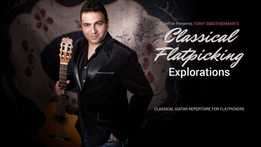Tony Smotherman — Classical Flatpicking Explorations
 Тони Смотерман: «Классические медиаторные исследования».
Тони Смотерман: «Классические медиаторные исследования».
Ноты, табы для гитары, видео.
Репертуар классической гитары для играющих медиатором.
Эти 10 захватывающих аранжировок положат начало вашему репертуару классических произведений для флэтпикеров. Сыграйте их для семьи, друзей или даже на своем следующем сольном концерте.
Содержание:
Minuet — ”Mozart’s music transcribes so well to the guitar. In this minuet, you’ll notice lots of string skipping and position changes within the scale runs. Mozart was well known for his harmonies and masterful ability to make his pieces sound elaborate, while often built on very basic musical concepts. This minuet is a great example of how Mozart crafted incredible harmonically rich lines in an almost playful manner.”
La Catedral 3rd Movement — ”The music of Augustín Barrios is held in high regard in the classical guitar world. A Paraguayan born guitarist himself, «La Catedral» is one of his most famous pieces. The section I’ve chosen is the 3rd movement of «La Catedral», an amazing study in position shifting and picking through arpeggiated chords. On top of that, it’s one of the most incredibly written pieces I’ve ever heard.”
Badinerie — ”Badinerie is the final movement of the Orchestral Suite No. 2 in B minor by Johann Sebastian Bach. This was originally written for flute, hence the cascading arpeggio run that translates nicely to guitar. This movement is lots of fun to play and really evokes the Baroque-era sound Bach was famous for. I personally can hear the whole orchestra in this piece when playing through it.”
Etude No.1 in E minor — ”Heitor Villa-Lobos was a Brazilian guitarist and composer. His works are among the most brilliant in the genre. Villa-Lobos is known for his quirky and exotic sounding chords in his pieces. Etude No.1 is no exception, it’s comprised of string skipped arpeggios throughout and interesting chord changes. This piece is up at the top of the list of classical numbers that sounds great when picked as well as beautiful to listen to.”
Canon in D — ”Canon in D is a very famous classical number. Because of its slow and beautiful melody, it’s often used for weddings. This version uses string skipping arpeggios to play through the chord progression. This one sounds equally as nice played on an electric guitar with distortion. The chord progression makes use of simple major and minor chords.”
Opus 60 Study No.7 in A Minor — ”Carcassi was an incredible guitar composer. His pieces always remain accessible but very clever harmonically. «Study No. 7 in A Minor» is a well-known Carcassi piece in the classical guitar community. Most people know it as Carcassi #7. The first time I heard this piece, I loved it and immediately learned it. The cool thing about this is that it sounds like two guitars simultaneously. Carcassi wrote lots of music for the guitar and this one translates so well to using a pick.”
Invention No.4 — ”Bach wrote 15 «inventions», originally written as exercises for his students (including his own children). The 4th invention is one of my favorites! It sounds great on classical guitar, steel string, and even on electric cranked through the amp with some heavy gain. You’ll again hear the Baroque sound with Bach’s use of harmonic movement, scale choice, and overall writing style.”
The Turkish March — ”The «Turkish March» or «Turkish Rondo» written by Mozart is a masterful piece that translates well to almost any instrument. Essentially, what we’re doing here is playing what the right hand or treble clef would be playing on a piano. Once you get this down, try challenging yourself by playing along with a piano recording of it. Although he had many, this is one of Mozart’s greatest compositions in my opinion.”
Caprice No.5 — ”Niccolo Paganini was a one of a kind virtuoso violinist. Paganini wrote 24 «caprices» for solo violin. Each caprice is captivating in its own way. Many of his caprices are used by guitarists for dexterity, technique, arpeggio studies, and many other musical ideas the maestro employed in his playing. «Caprice No. 5» is a really great introduction for guitarists into the world of Paganini. If you’ve seen the old movie Crossroads with Steve Vai, you may recognize this segment of the piece, as it was featured at the end of the film in the guitar duel.”
Sonata No.1 for Solo Violin — ”Sonata No.1 for Solo Violin captures the true essence of what a Bach piece should be. This excerpt contains plenty of counterpoint, melodic motifs, and Baroque stylings. The challenge of this piece comes down to fingerings throughout. A few are quite tricky, it’s important to use correct fingers in order to play through each of the changes here. Make special note of the arpeggios used and what chords they correlate to. For fun, use the outline of this piece to combine your own major and minor arpeggios to construct your own caprice.”
pdf + mp4. Вес файлов 508 mb, папка. На английском языке. 2018 г.